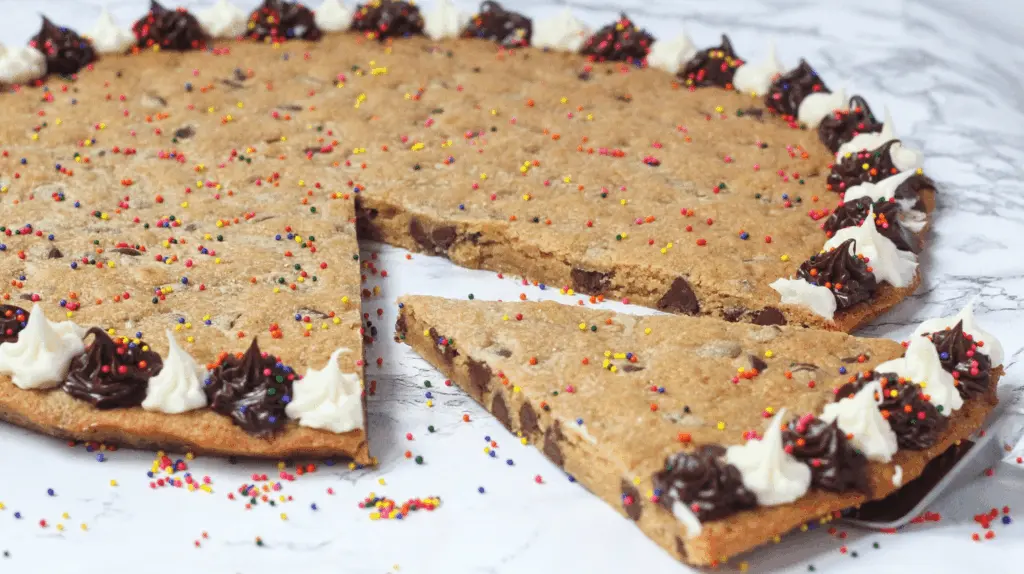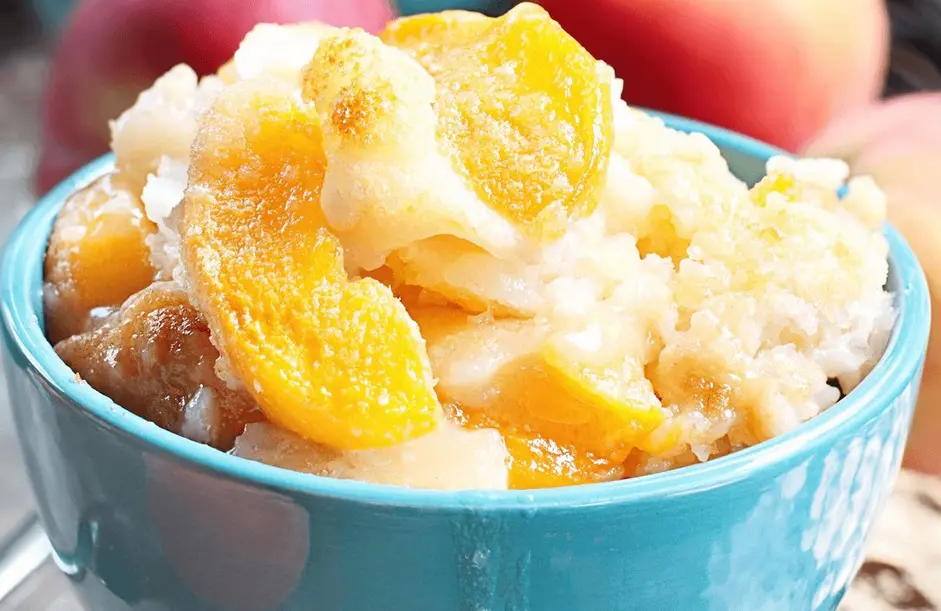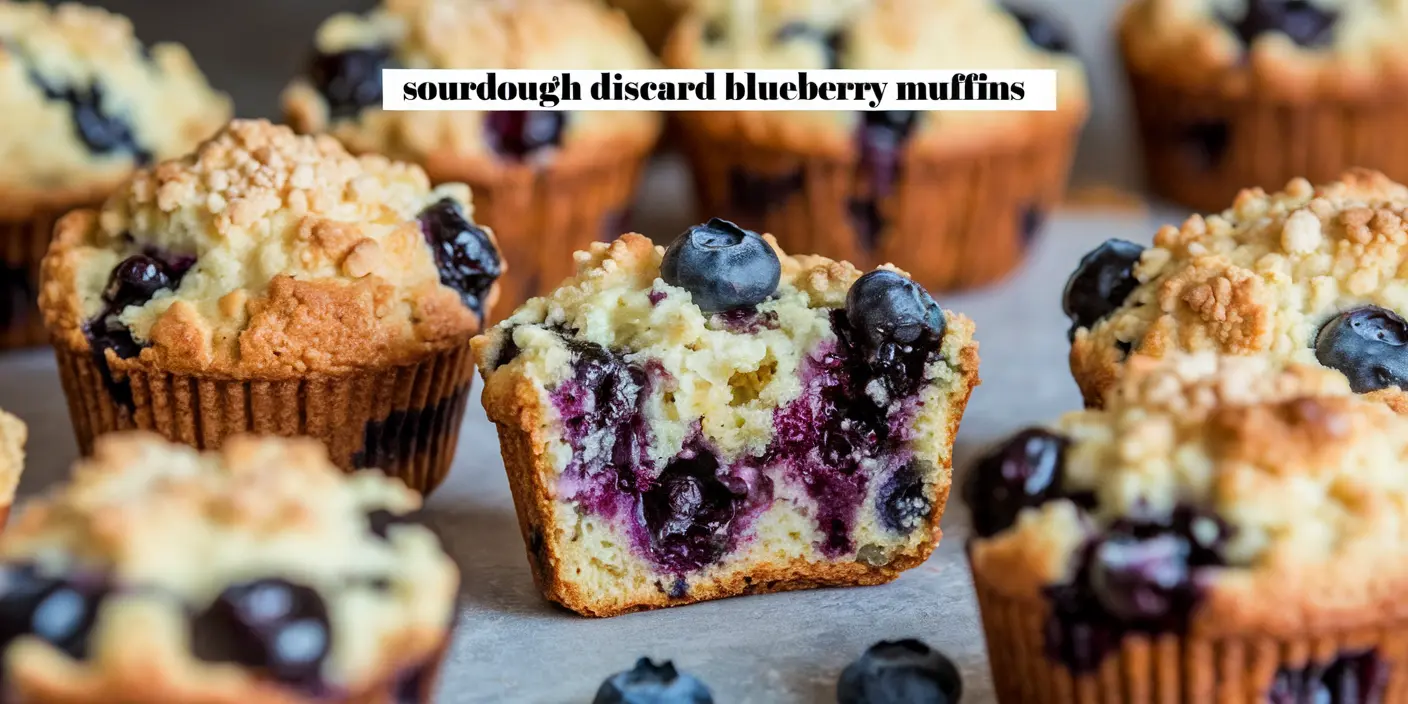
A cookie cake combines the delightful crunch of a cookie with the indulgent size of a traditional cake, making it a perfect centerpiece for any celebration. This oversized treat, often loaded with chocolate chips and adorned with festive frosting, offers a fantastic alternative to the classic birthday or celebration cake. Loved for its simplicity and the nostalgia it evokes, the cookie cake has been a favorite for both young and old at parties and gatherings.
In recent years, variations on the classic cookie cake recipe have flourished online, catering to all tastes and dietary requirements. From gluten-free to vegan cookie cake options, there’s a recipe out there for everyone. Whether you’re a seasoned baker or a novice looking to create something special, the cookie cake is remarkably forgiving and customizable.

Table of contents
What is a Cookie Cake?
A cookie cake is essentially a giant cookie, baked similarly to a traditional cake, that combines the chewy texture of cookies with the expansive size and shape of a cake. This dessert typically features classic cookie ingredients such as flour, eggs, and chocolate chips, but it’s baked in a large pan to create a single, sizable treat that can be sliced and served like a cake. Ideal for sharing, cookie cakes make a popular choice for birthday celebrations, school parties, and other gatherings where people desire a delicious and eye-catching dessert.
Unlike regular cookies that are small and individually portioned, a cookie cake offers the same beloved flavors in a format that is easier to customize and decorate. This makes it not only a convenient option for serving large groups but also a perfect canvas for creative decorations like icing and sprinkles.
Key Ingredients and Substitutions
Creating a delicious cookie cake starts with a few essential ingredients that are likely already in your pantry. The foundation of any cookie cake includes all-purpose flour, which provides structure; baking powder and baking soda, which help the cake rise; and a touch of salt to enhance flavors. Sugars—both granulated and brown—are crucial for sweetness and texture, with brown sugar imparting a moist, chewy quality. Large eggs bind the mixture together, while pure vanilla extract adds a rich, aromatic flavor. The star of the show, semisweet chocolate chips, ensures that every bite is loaded with chocolatey goodness.
However, one of the joys of baking a cookie cake is the ability to adapt the recipe to meet dietary needs or taste preferences. For those avoiding gluten, substitute the all-purpose flour with a gluten-free blend that can be used in a one-to-one ratio. If you’re catering to a vegan diet, replace the eggs with alternatives like flax eggs or commercial egg replacers. For a butter substitute, try using coconut oil or a vegan butter, which lend similar richness and moisture.
For those looking to enhance the flavor or texture, consider incorporating bold ingredients such as peanut butter chips or white chocolate chips for a twist on the traditional recipe. To cater to different dietary preferences, you might also swap out the semisweet chocolate chips for dairy-free chocolate to make the dessert vegan-friendly.
In addition to these substitutions, it’s possible to experiment with the types of sugar used. For a deeper, caramel-like flavor, increase the proportion of brown sugar or even use coconut sugar as a healthier alternative. These small tweaks allow you to customize the cookie cake to suit any occasion or dietary need, ensuring everyone can enjoy a slice of this beloved treat.
Step-by-Step Baking Guide
Baking a cookie cake is an enjoyable and straightforward process that combines the familiarity of making cookies with the grandeur of a cake. This guide will walk you through the necessary steps to ensure your cookie cake turns out perfectly, from the initial mixing to the final baking.
Preparation:
- Gather Your Ingredients: Start by assembling all your ingredients: all-purpose flour, baking soda, baking powder, salt, butter (melted and cooled), granulated sugar, brown sugar, a large egg, vanilla extract, and chocolate chips. This preparation helps streamline the baking process.
- Preheat Your Oven: To preheat your oven, set the temperature to 350°F (175°C). This temperature is ideal for ensuring a gooey center with slightly crisp edges.
Mixing the Dough:
3. Combine Dry Ingredients: In a small bowl, whisk together the flour, baking powder, baking soda, and salt. This step ensures that your leavening agents are evenly distributed throughout the flour, which promotes even rising.
- Cream Butter and Sugars: In a larger bowl, mix the melted butter with both sugars until well combined. This mixture should look glossy and smooth, which is critical for the texture of the cake.
- Add Egg and Vanilla: Beat in the egg and vanilla extract until the mixture is light and fluffy. This introduces air into the dough, which helps in leavening the cookie cake.
- Incorporate Dry Ingredients: Gradually add the dry ingredients to the wet mixture, stirring until just combined to avoid overworking the dough, which can make the cake tough.
- Fold in Chocolate Chips: Stir in the chocolate chips, ensuring they are evenly distributed throughout the dough for a consistent flavor in every slice.
Baking the Cookie Cake:
8. Prepare the Pan: Lightly grease a 10-inch round baking pan or cast iron skillet. To make the removal easier, you can line it with parchment paper.
- Spread the Dough: Transfer the dough to the pan that you have prepared. Use a spatula or your hands to evenly press the dough across the bottom of the pan.
- Bake: Place the pan in the preheated oven and bake for 20-25 minutes. The edges should set and turn lightly golden, while the center remains soft and slightly undercooked. This timing creates a fudgy texture in the center with a delightful crisp on the edges.
Cooling and Serving:
11. Cool on a Wire Rack: Allow the cookie cake to cool in the pan on a wire rack to prevent it from continuing to cook from residual heat.
- Decorate: Once cooled, you can decorate the cookie cake with frosting, sprinkles, or any other decorative toppings to enhance its visual appeal and add flavor.
This step-by-step guide ensures that your homemade cookie cake will be a hit at any gathering, providing a chewy, chocolaty treat that’s both comforting and celebratory.

Decorating Your Cookie Cake
Once your cookie cake has baked and cooled, the next step is decorating—a process that enhances its appearance and flavor. Whether for a special occasion or just to be creative, here are some tips for decorating your cookie cake.
Choosing Your Frosting:
- Buttercream Frosting: For a classic look and taste, buttercream frosting is a favorite. It’s creamy, easy to color with food dyes, and holds up well for intricate designs with a piping bag.
- Chocolate Ganache: If you’re a chocolate lover, consider a rich chocolate ganache. It spreads smoothly and hardens slightly as it cools, giving a glossy, decadent finish.
- Cream Cheese Frosting: For those who prefer a tangy contrast to the sweetness of the cookie cake, cream cheese frosting is an excellent choice. It pairs especially well with chocolate chip and red velvet cookie cakes.
Decorative Touches:
- Writing and Patterns: Using a piping bag fitted with a fine tip, you can add messages, names, or delicate patterns to personalize the cookie cake.
- Edible Decorations: Sprinkles, edible glitter, or even themed edible images can be added to match the occasion—be it a birthday, holiday, or just a fun family gathering.
- Fresh Ingredients: Fresh fruits like strawberries or blueberries, or even a sprinkle of nuts or toffee bits, can enhance both the look and the taste of your cookie cake.
Creative Ideas:
- Themed Decorations: Match the decoration to the party theme. For example, use colors and toppings that align with the season or the theme of the event.
- Layering: For an extra indulgent treat, add a layer of cookie or brownie chunks, caramel drizzle, or marshmallow fluff between two thin cookie cakes.
Decorating your cookie cake can be as simple or as elaborate as you like. Each element enhances both the appearance and flavor, making the cookie cake a versatile and enjoyable dessert.
Common Mistakes and Troubleshooting
Even experienced bakers can encounter issues when making a cookie cake. Here are some common mistakes and troubleshooting tips to ensure your cookie cake turns out just right.
Underbaking and Overbaking:
- Underbaked: A gooey center is desired, but an underbaked cookie cake can be too raw and difficult to slice. If the center seems uncooked, extend the baking time in 5-minute increments, checking regularly until the desired consistency is reached.
- Overbaked: Overbaking can lead to a dry and hard cookie cake. To prevent this, remove the cake while the center is slightly soft; it will continue to cook from residual heat.
Dough Spreading Too Thin or Too Thick:
- Too Thin: If your dough spreads out too much in the pan, it’s likely due to too little flour. Ensure you measure your flour correctly, ideally using a kitchen scale or the spoon-and-level method.
- Too Thick: Conversely, a dough that’s too thick might not spread adequately, leading to an uneven bake. This can be fixed by pressing the dough down more uniformly in the pan before baking.
Texture Issues:
- If the cookie cake is too crispy or tough, it could be from over-mixing the dough. Mix just until the ingredients are combined to maintain a tender texture.
Storage and Make-Ahead Tips
Proper storage is key to maintaining the freshness and texture of your cookie cake. If you’re planning to serve your cookie cake within a few days, it can be stored at room temperature. Simply place it in an airtight container or wrap it tightly with plastic wrap to keep it moist and prevent it from drying out. For longer storage, refrigerate cookie cakes for up to a week or freeze them for up to three months. To freeze, first allow the cookie cake to cool completely and, if already frosted, wait until the frosting has hardened. Wrap the entire cake or individual slices securely in plastic wrap followed by a layer of aluminum foil to protect against freezer burn.
For those looking to prepare ahead of time, you can make the cookie dough and store it in the refrigerator for up to three days before baking. Alternatively, shape the dough into the desired cake form, wrap it tightly, and freeze it. To prepare for baking, thaw overnight in the refrigerator and then bake according to the instructions. These make-ahead tips not only save time but can also enhance the flavor of the cookie cake, as the dough matures and develops deeper flavors.

FAQs
Can I make a cookie cake with store-bought cookie dough?
Yes, you can use store-bought cookie dough for a cookie cake. Just press the dough into a suitable pan and adjust the baking time based on its thickness. Always check for doneness at the earliest recommended time for best results.
How do I ensure my cookie cake has a soft center and crispy edges?
Achieving the perfect texture in a cookie cake involves careful timing and temperature control. Bake your cookie cake at 350°F and start checking for doneness after about 15-20 minutes. The edges should be golden and set, while the center remains slightly undercooked. Remove the cake from the oven slightly underdone; residual heat will finish cooking the center without overcooking the edges.
What are the best toppings for a cookie cake?
Popular toppings include frosting (like chocolate or vanilla buttercream), sprinkles, chopped nuts, and caramel or chocolate sauce. Themed sprinkles or sugar decals also make festive additions for special occasions.
Can I use different types of chocolate in my cookie cake?
Absolutely! While semisweet chocolate chips are traditional, you can use any type of chocolate you prefer. Consider using milk chocolate for a sweeter taste or dark chocolate for a richer flavor. Chocolate chunks or even flavored chips like white chocolate or peanut butter can add interesting texture and taste variations.
How do I store leftover cookie cake?
Store leftover cookie cake in an airtight container at room temperature for up to 3 days. You can wrap individual slices and refrigerate for up to a week or freeze for extended storage. Ensure the cookie cake is covered or wrapped tightly to maintain its moisture and texture.





